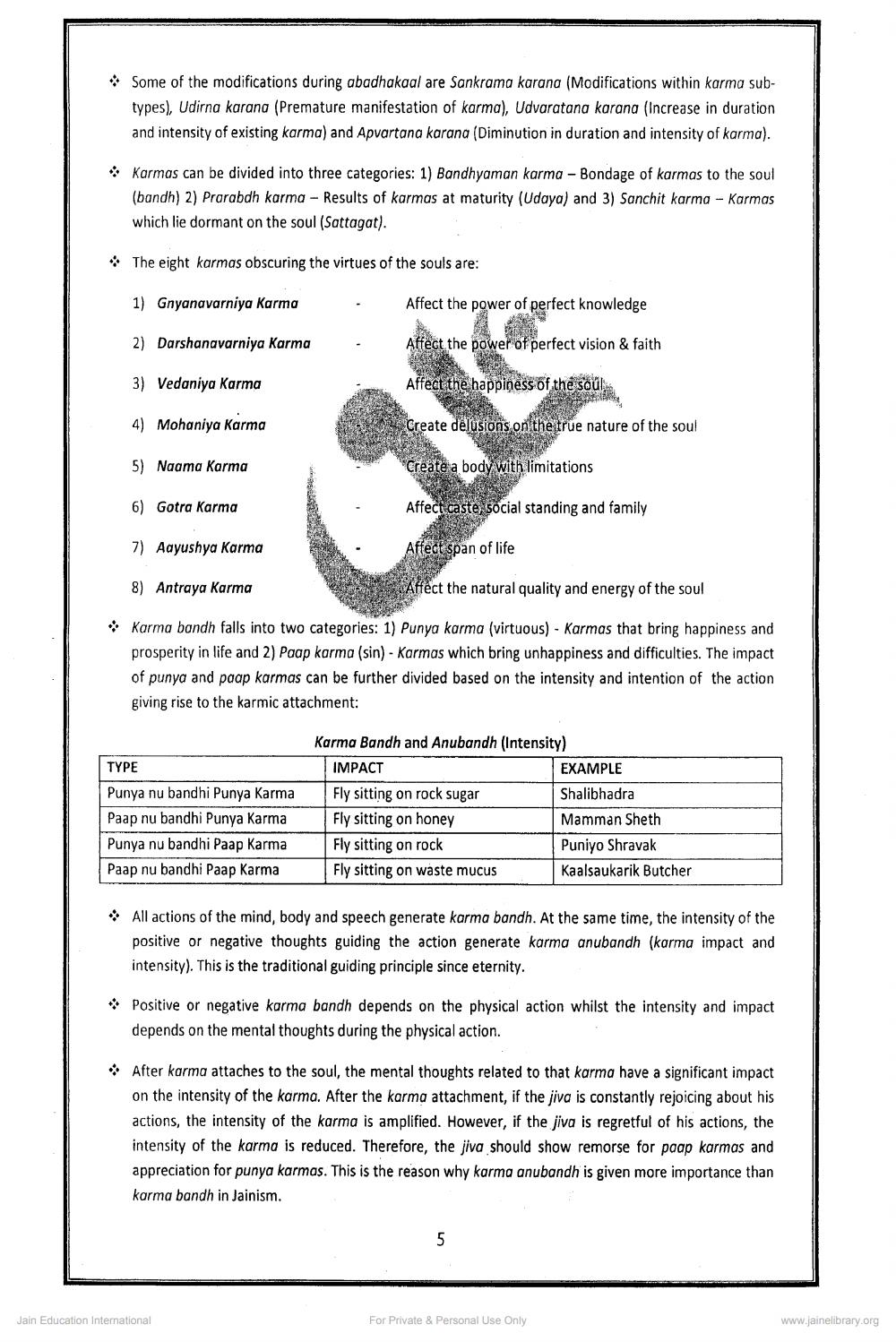Book Title: Karma Vignayan Shibir-2008-2009 Author(s): Jinchandra Acharya Publisher: ZZZ Unknown View full book textPage 5
________________ Some of the modifications during abadhakaal are Sankrama karana (Modifications within karma subtypes), Udirna karana (Premature manifestation of karma), Udvaratana karana (Increase in duration and intensity of existing karma) and Apvartana karana (Diminution in duration and intensity of karma). Karmas can be divided into three categories: 1) Bandhyaman karma - Bondage of karmas to the soul (bandh) 2) Prarabdh karma - Results of karmas at maturity (Udaya) and 3) Sanchit karma - Karmas which lie dormant on the soul (Sattagat). The eight karmas obscuring the virtues of the souls are: 1) Gnyanavarniya Karma Affect the power of perfect knowledge 2) Darshanavarniya Karma - Affect the power of perfect vision & faith 3) Vedaniya Karma 4) Mohaniya Karma Affect the happiness of the souls Create delusions, onthetrue nature of the soul Create a body with limitations 5) Naama Karma 6) Gotra Karma Affect caste social standing and family 7) Aayushya Karma Affect span of life 8) Antraya Karma Affect the natural quality and energy of the soul Karma bandh falls into two categories: 1) Punya karma (virtuous) - Karmas that bring happiness and prosperity in life and 2) Paap karma (sin) - Karmas which bring unhappiness and difficulties. The impact of punya and paap karmas can be further divided based on the intensity and intention of the action giving rise to the karmic attachment: TYPE Punya nu bandhi Punya Karma Paap nu bandhi Punya Karma Punya nu bandhi Paap Karma Paap nu bandhi Paap Karma Karma Bandh and Anubandh (Intensity) IMPACT EXAMPLE Fly sitting on rock sugar Shalibhadra Fly sitting on honey Mamman Sheth Fly sitting on rock Puniyo Shravak Fly sitting on waste mucus Kaalsaukarik Butcher All actions of the mind, body and speech generate karma bandh. At the same time, the intensity of the positive or negative thoughts guiding the action generate karma anubandh (karma impact and intensity). This is the traditional guiding principle since eternity. * Positive or negative karma bandh depends on the physical action whilst the intensity and impact depends on the mental thoughts during the physical action. After karma attaches to the soul, the mental thoughts related to that karma have a significant impact on the intensity of the karma. After the karma attachment, if the jiva is constantly rejoicing about his actions, the intensity of the karma is amplified. However, if the jiva is regretful of his actions, the intensity of the karma is reduced. Therefore, the jiva should show remorse for paap karmas and appreciation for punya karmas. This is the reason why karma anubandh is given more importance than karma bandh in Jainism. Jain Education International For Private & Personal Use Only www.jainelibrary.orgPage Navigation
1 ... 3 4 5 6 7 8 9 10 11 12 13 14
